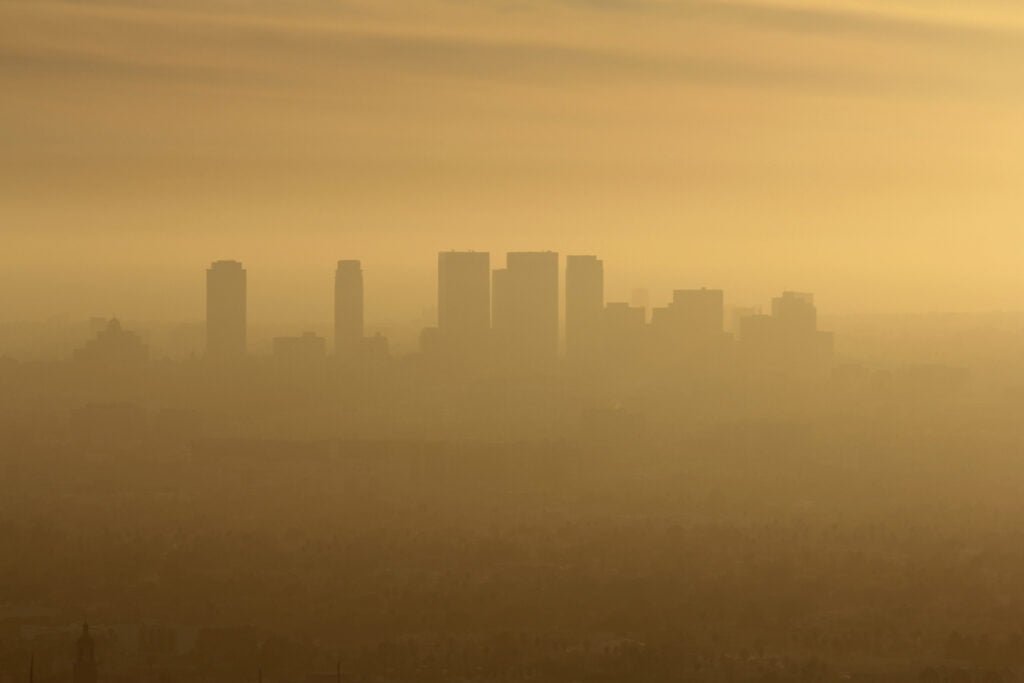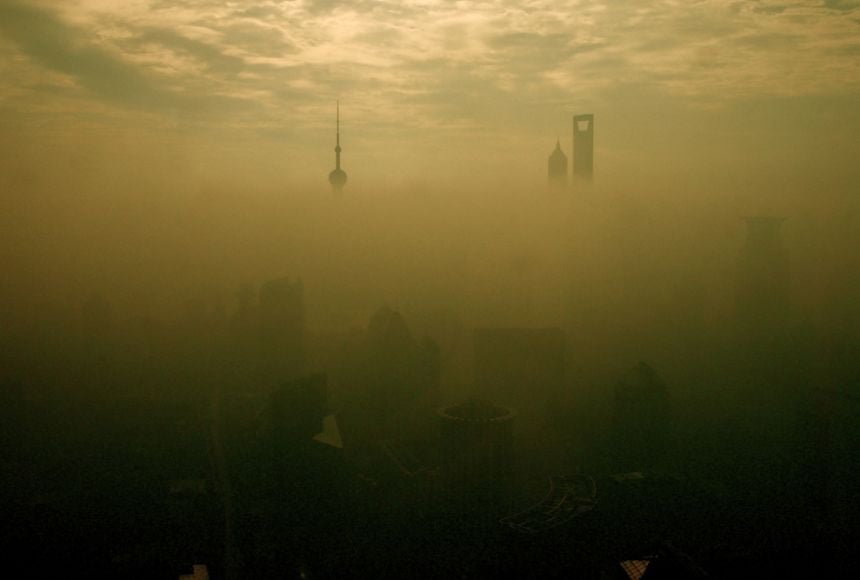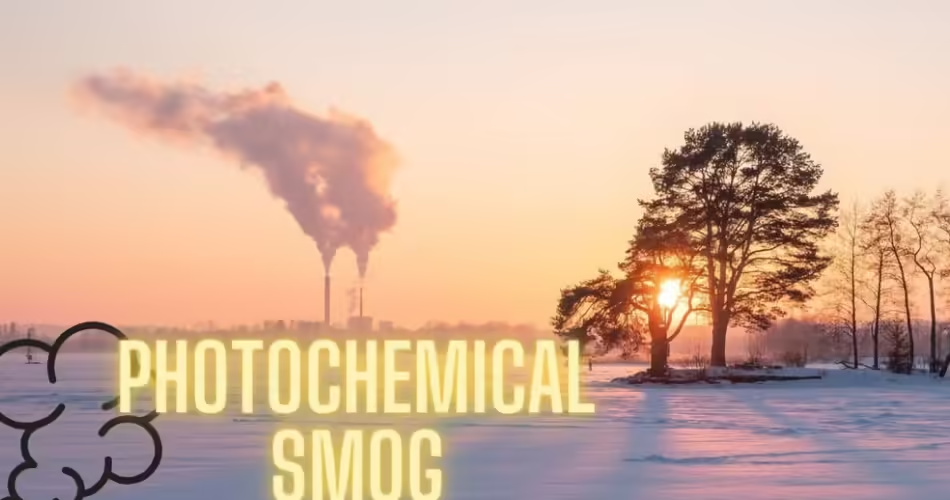This blog contains information about Photochemical Smog. In the start, this blog defines and introduce Photochemical Smog. Then it discusses the Natural Causes of Photochemical Smog. After that it explains the Anthropogenic Causes of Photochemical Smog. It also elaborates the Effects of Photochemical Smog on Plants, Animals and Humans in detail. In the end, it mentions few Control Measures about Photochemical Smog. This blog contains Causes, Effects and Control Measures of Photochemical Smog.
Photochemical Smog:
“It is a mixture of pollutants that are formed when nitrogen oxides and VOC (Volatile Organic Compounds) react with sunlight and creates a brown haze over cities”
This Smog is mostly expected in Summers, because the sunlight is at its extreme during summer period. There is more availability of sunlight in these days.
Primary pollutants that becomes the source of Photochemical Smog are Nitrogen oxides (NOx) and VOCs. While the secondary pollutant involved is Ground-level Ozone, which is a very harmful pollutant on the surface of earth (Although Stratospheric ozone is essential to make life possible on Earth).
Photochemical smog is invisible most of the time. But the bitter truth is that it has more harmful impacts that the visible smog and it can be adverse on health of living organisms on earth.
Natural Causes of Photochemical Smog:
Following are some of the natural causes of this type of Smog:
Bushfire and other Natural Fires:
Natural fires includes lightening, forest fires, bushfires, etc. adds a great amount of toxic gases such as Nitrogen oxides. These are the source of natural addition to toxic air pollutants that adds into the formation of photochemical smog. This does not include human interference.
Microbial Processes:
Microbial process such as decomposition of organic matter through bacteria are also a source nitrogen oxides by natural means. The decomposition by natural processes emit large amounts of nitrogen oxides in the atmosphere, that eventually adds into the formation of Photochemical smog when it reacts with sunlight and form Acid Rain when react with rain water.
Evaporation:
Evaporation of naturally occurring or synthetic solvents from different solutions and polluted water also adds Nitrogen oxides, Sulphur oxides and VOCs into the atmosphere. This also constitutes into concentrations of toxic air pollutants into the atmosphere. These gases are harmful for all Earth processes and living organisms on Earth.
These are the natural sources of Photochemical smog formation. This blog contains Causes, Effects and Control Measures of Photochemical Smog.

Anthropogenic Causes of Photochemical Smog:
Following are the Anthropogenic Causes of this Smog:
Burning of Fossil Fuels:
Burning of Fossil fuels is a great cause of formation of Photochemical smog. After the start of industrial era, fossil fuel combustion has become very common and adds to a lot of Green House Gases (GHG) concentrations in the atmosphere. It adds CO2, NOX and SOX into the air. This adds concentrations for the formation of Photochemical Smog.
Incomplete Combustion of Fossil Fuels:
In most of the factories, there is an incomplete combustion of fossil fuels that lead to the excessive concentrations of some of the Major Air pollutants into the air. These major air pollutants when reacts to sunlight, it form photochemical smog. It forms invisible smog that is way more harmful than visible smog.
Burning of Nitrogen-rich fuels:
Nitrogen-rich fuels when burnt into the incinerators, lead to the emissions of NOx or nitrogen oxides. These nitrogen oxides are the great component of Photochemical Smog.
Burning of Sulfur-rich fuels:
Fuels rich in sulfur cause the emissions of Sulfur oxides and addition of these gases in the air in high concentrations. SOX are also a major component of Photochemical Smog.
These were the major causes of formation of Photochemical Smog.
Effects of Photochemical Smog on Human Health:
Smog is composed of a mixture of air pollutants which can endanger human health.
Various human health problems such as emphysema, asthma, chronic bronchitis, lung infections, and cancers are caused or exacerbated by the effects of smog. The effects include:
• Coughing and irritation of the eyes, chest, nose and throat:
High ozone levels can irritate the respiratory system leading to coughing and wheezing. These effects generally last for only a few days after exposure, but the particles in the smog can continue to damage the lungs even after the irritations disappear.
• Aggravation of asthma:
Asthma conditions are severely worsened by smog and can trigger asthma attacks. Asthmatic patients are more vulnerable than all the healthy individuals on earth in the presence of Photochemical Smog.
• Breathing difficulties and lung damage:
Bronchitis, pneumonia, and emphysema are some of the lung conditions linked to the effects of smog as it damages the lining of the lungs. Smog also makes it difficult for people to breathe properly.
• Premature deaths because of respiratory and cancer diseases:
A 2013 “WHO” report indicated that cumulative exposure to smog heightens the chances of premature death from cancers and respiratory diseases. Thousands of premature deaths in the United States, Europe, and Asian countries associates to inhalation of smog particles.
Such chemical particles include benzene, formaldehyde, and butadiene which are all comprised of cancer-causing carcinogens.
• Birth defects and low birth weights:
Smog has a direct link to birth defects and low birth weight. Pregnant women who have been exposed to smog have had babies with birth defects. Spina bifida – a condition depicting malformations of the spinal column, and anencephaly – underdevelopment or absence, or only part of the brain, are birth defects associated with smog exposure. Furthermore, studies suggest that even as low as 5 ug exposure to smog particulate matter can result in risks of very low birth weights at delivery.
• The risk of developing Rickets:
Heavy smog that lasts for prolonged periods blocks UV rays from reaching the earth surface. This results in low production of Vitamin D leading to rickets due to impaired metabolism of calcium and phosphorus in the bone marrow.
• Risks of road accidents or even plane crash:
Smog interferes with natural visibility and irritates the eyes. On this basis, it may prevent the driver or flight controller from reading important signs or signals thereby increasing the probability of road accidents or even plane crash.
Implications for Plants and Animals:
• Smog Effects for Plants:
Smog inhibits the growth of plants and can lead to extensive damage to crops, trees, and vegetation. When crops and vegetables such as wheat, soybeans, tomatoes, peanuts, cotton and kales are available to smog, it interferes with their ability to fight infections thus increasing susceptibility to diseases.
• Smog Effects for Animals:
The smog’s impact of altering the natural environment makes it difficult for animals to adapt or survive in such toxic conditions, which can kill countless animal species or make them susceptible to illness.
. Photochemical smog caused when nitrogen oxides react in the presence of sunlight, is established to destroy plant life and irritate sensitive tissues of both plants and animals. This blog contains Causes, Effects and Control Measures of Photochemical Smog.

Control Measures:
As we all know that, we cannot control natural phenomena such as rain, smog, fog, earthquakes and photochemical smog. But we can take preventive measures to control the Anthropogenic contributions in these harmful phenomena. The only thing we can do against photochemical smog is reducing the GHGs emissions. Following are the preventive measures that we should take to prevent Photochemical smog:
- We should replace fossil fuels from biofuels.
- Must use complete combustion systems instead of incomplete combustion.
- We should reduce the carbon footprint overall.
- Must remove sulfur from sulfur-rich fuels before incineration.
- We should remove nitrogen from nitrogen-rich fuels before its burning process.
- We should install scrubbers to remove hazardous air pollutants before entering into the air.
- Must avoid water pollution to prevent the polluted evaporation into the atmosphere.
By following these control measures, we can reduce the harmful effects of Photochemical Smog on the environment and human health.
Conclusion:
Photochemical smog is a mixture of pollutants that are formed when Nitrogen oxides and VOCs when they react with sunlight. It have very bad impacts on living things including humans, animals and plants. It cause respiratory disease to humans and trigger all the pre-existing heart and respiratory diseases in humans. While in plants, it cause the inhibition of growth and damage of crops. In animals, it makes survival difficult by adding pollutants to their natural environment that can cause damage to their tissues and irritation in their bodies. Photochemical Smog is formed by anthropogenic pollutants that are cause of death of millions of people every year. We should limit the emissions by industries to fight from this hazardous effect of air pollution. This blog contains Causes, Effects and Control Measures of Photochemical Smog.


Comments